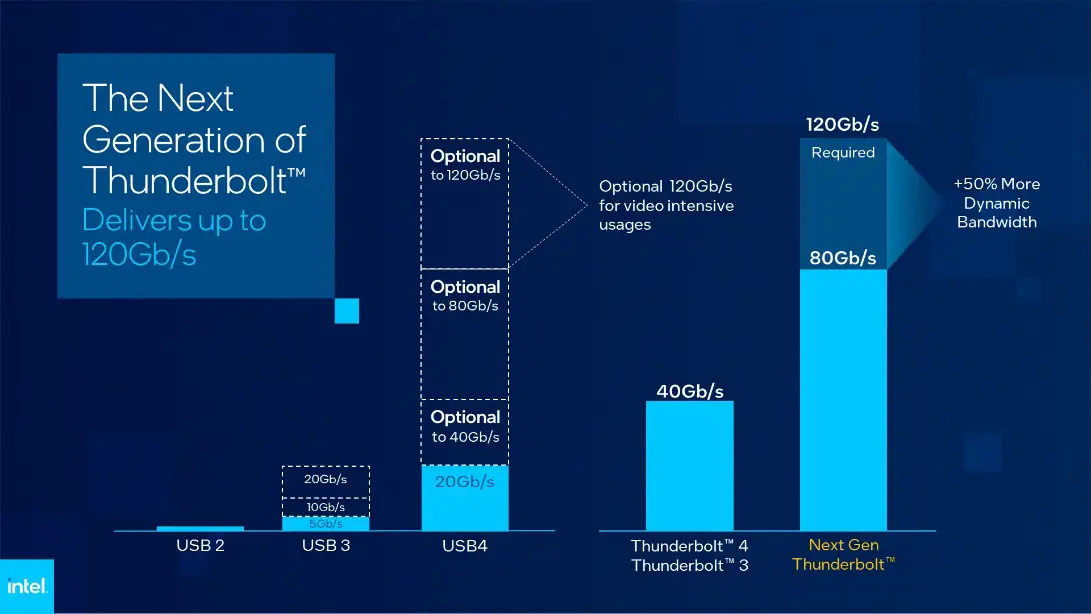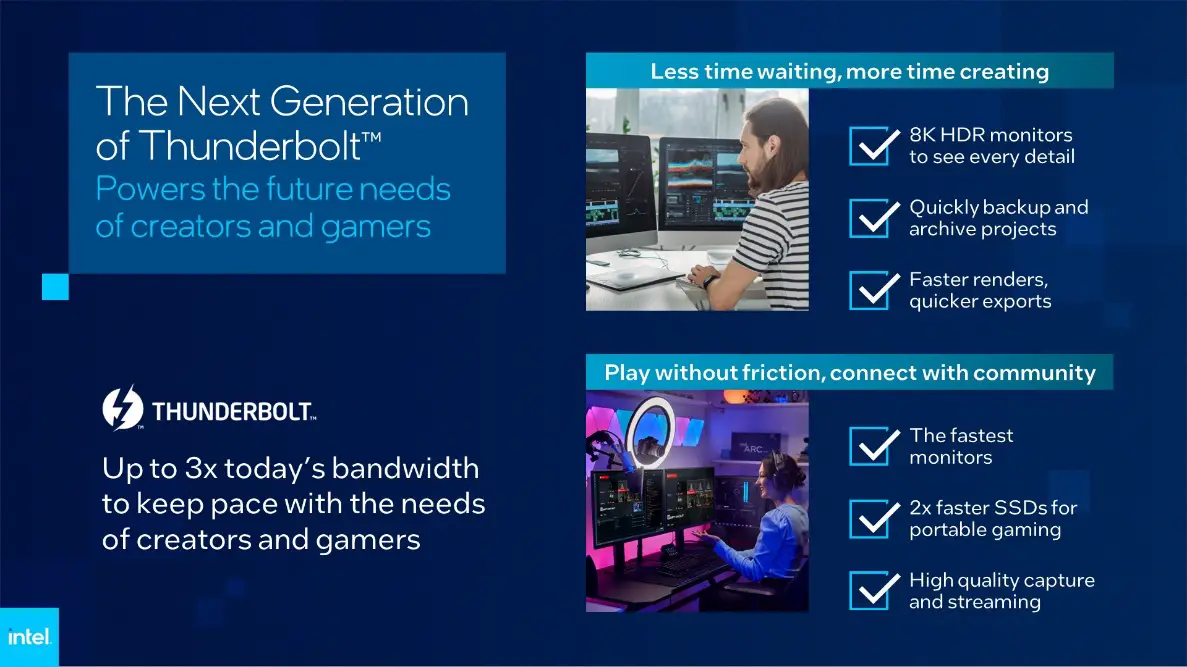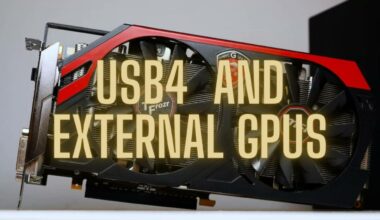Intel Unveils Next-Generation Thunderbolt
Although Intel isn’t calling it Thunderbolt 5 yet, they have unveiled the future Thunderbolt technology. In a recent news item, Intel shares a glimpse of what you can expect from the next iteration of this popular connectivity protocol.
The news confirms key aspects like technology and data transfer speeds that the next iteration will employ. But, it leaves plenty of unanswered questions, adding to the speculation that started when a high-ranking Intel executive accidentally posted the details.
Table of Contents

Here is all that we know and all that we still want to know about the future of Thunderbolt.
Thunderbolt 5: The Details
Even though Intel hasn’t already named it Thunderbolt 5, for the sake of convenience, let’s call it that.
Data Speeds and Bi-directional Channels
Intel confirms that Thunderbolt 5 will offer data transfer speeds of 80Gbps, double that of Thunderbolt 4. What’s more, in specific scenarios like using 8K display screens, Thunderbolt 5 will even deliver data speeds of 120Gbps. So, Thunderbolt 5 not only doubles but also triples the total bandwidth of Thunderbolt 4 and leaves USB far behind when you consider the minimum speeds.

Thunderbolt 5 will use four bi-directional channels, each with 40Gbps of bandwidth, two for each direction. To attain the 120Gbps data transfer speed, Intel uses dynamic re-balancing that’ll allow one of the channels to choose the direction of transmission dynamically. Thus, you’ll get higher refresh rates while watching 8K videos, that’ll enhance your viewing experience, and gamers will love the extraordinary gaming experience.

Technology
One of the critical details leaked was that Thunderbolt 5 would use Pulse-Amplitude Modulation, or PAM 3, for signaling. Intel mentions that Thunderbolt 5 is based on USB 4 v2, essentially meaning that the technology uses PAM-3 signaling.
Thunderbolt 5 will also use DisplayPort v2.1 standards for video signaling to support high-resolution and high-refresh rates. Thus, content creators and games will get better visuals and immersive experiences.
Cable
Intel confirms that Thunderbolt 5 is compatible with passive cables measuring up to 1m (3.2 feet). And you can rest assured that it will use USB-C connectors and continue to provide PCIe, display, and Power delivery on a single cable.
Essentially, this is all there is to know about Thunderbolt 5 for the time being. Intel has only showcased an early version of Thunderbolt 5, which, on Intel’s own admission, is still currently under development. Hence, this means that a lot is still unknown about the technology. Let’s have a look.
Thunderbolt 4 Vs. Thunderbolt 3
To understand the nature of the technology, you’ll first need to understand the context of how Thunderbolt 4 improved upon Thunderbolt 3.
While Thunderbolt 3 and Thunderbolt 4 offer the same 40Gbps bandwidth, only Thunderbolt 4 supports 8K video. The best Thunderbolt 3 can do is dual-4K or one 5K video.
However, the difference becomes more apparent when you compare a few baseline parameters. For instance, while Thunderbolt 3 states 16Gbps as the minimum PCIe speed, Thunderbolt 4 doubles it to 32Gbps. Next, Thunderbolt 4 supports up to four Thunderbolt ports on a dock, and Thunderbolt 3 supports only two. Thunderbolt 4 supports features like wake-from-sleep and Intel VT-d base Direct Memory Access protection.

Thunderbolt 5: The Unknowns
Presently, there is plenty of speculation surrounding Thunderbolt 5. There are several questions on everyone’s mind, and we can only venture a guess along with a possible explanation.
What will be the minimum PCIe bandwidth of Thunderbolt 5?
If Thunderbolt 4 is anything to go by, we would guess that Intel may not increase the minimum from 40Gbps just yet. They may wait for the next iteration when 8K is more widely accepted.
Will Thunderbolt 5 support dual-8K?
No, that would be our guess. The world hasn’t wholly embraced 8K yet. Moreover, 8K monitors will be huge, leaving little scope for a dual-monitor setup.
However, it is reasonable to expect support for three or more thunderbolt 4K monitors, which is ideal for content creators and gamers.
Up to what number of Thunderbolt 5 ports will the dock support?
Assuming our previous guess regarding dual-8K is true, it would be safe to guess that Thunderbolt 5 will also support up to four ports, like Thunderbolt 4.
Will it support more than 100W Power Delivery?
With some power-hungry laptops already on the market and USB-IF (Implementer Forum) allowing USB-C to offer up to 240W, Thunderbolt 5 will follow suit and offer the same. However, we wouldn’t expect Intel to change the 15W minimum that both Thunderbolt 3 and Thunderbolt 4 offer to charge devices that require lesser power.
How many devices will Thunderbolt 5 allow you to daisy-chain?
There are very few use cases that would require you to daisy-chain more than six devices that Thunderbolt 4 permits. However, you can put that down to our limited imagination. But considering Thunderbolt 5 with PAM-3 signaling and the massive bandwidth it brings, you may see an increase only if there are justifiable use cases.
Nevertheless, as one of our readers corrected us, Thunderbolt is limited architecturally to daisy chain up to six levels, so no point in guessing what to expect on this front.
Thunderbolt 5: Use Case
The leap from 40Gbps to 80Gbps, and possibly 120Gbps, is a clear indication of what it wants to offer to gamers and content creators. The high bandwidth translates into higher resolutions and refresh rates, meaning you’ll get superior picture quality like never before.
And with faster data transfers maintaining your media and gaming library would be super convenient. Gamers can expect the next level in portable gaming while streaming high-resolution content for their subscribers and fans.

Thunderbolt 5 Release Date
Thunderbolt 5 is a work in progress, and Intel doesn’t have a date set for its release. According to Intel, Thunderbolt 5 is currently under development, which means you’ll have to wait for the development and testing before Intel finally decides to release this technology. Little is known about where the project stands, but if expert opinions are anything to go by, don’t expect anything in a hurry. Our guess would be late 2023. Of course, getting your hands on the first commercial piece of tech would be longer.






